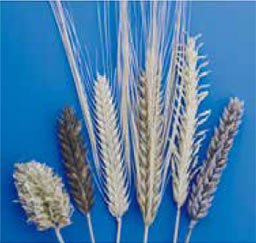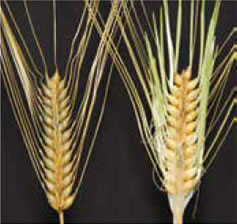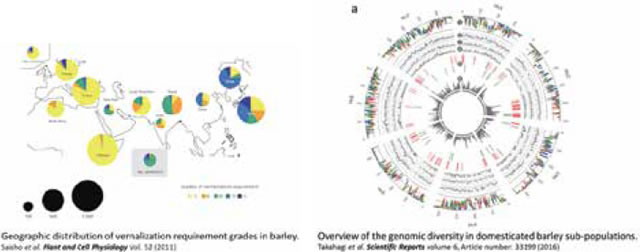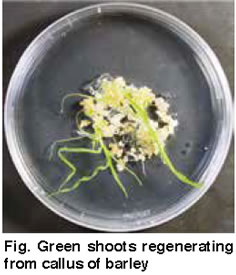Research Area : Plant Diversity Analysis
Preservation and application of genetic and genomic resources in barley
Ca. 15,000 accessions of wild and cultivated barleys and a wide range of experimental strains are preserved with a support from the National Bioresrouce Project. Genomic libraries and extensive cDNA resources have been developed for genomic analysis of barley which contributed to estimate gene regions on the draft barley genome sequence published in 2012.
These genetic and genomic resources are used to identify agriculturally important genes on barley genome. We also found that barley and diploid wheat shared the same genomic structure and barley can be used as a diploid model of the Triticeae species, including wheat, barley and rye.

Gene isolation in barley

The study focuses on isolation and characterization of genes controlling industrially important traits using the genome diversity of barley. A recent example is a gene corresponding for barley seed dormancy (Qsd1), which is associated with pre-harvest sprouting and malting for brewing beer. Our analysis using a wild barley accession harboring a strong grain dormancy revealed novel insight into the genetic mechanism regulation grain dormancy in barley (Sato et al. 2016 Nat. Commun.).
The orthologous genes are also existed in wheat genomes which will be important to control seed dormancy in wheat.
Study on genetic diversity of crop species toward achieving sustainable crop productivity
Genetic diversity of target species is indispensable sources to breed new crop varieties to overcome food shortages under global environmental changes and population explosions. IPSR preserves more than 10,000 barley germplasm as not only for the research materials for plant science but also future resources to improve this crop species. The aims of our seed-bank activity as well as our research projects are to grasp the degree of the variation of traits associated with stress tolerance and ‘high-yield’ productivity and to understand genetic structure of the trait for mining the phenotypic diversity.
Deciphering the genetic diversity of domesticated barley spreading the entire world, we are evaluating agronomic traits such as vernalization requirement and salt tolerance at the germination stage. Genomic variation of the barley materials is explored using the next generation sequencing (NGS) technologies to make advances in our barley domestication history research. To uncover the genetic structure of the agronomic traits, multiple mapping populations such as recombinant inbred lines (RIL), chromosome segment substitution lines (CSSL) and nested association mapping population (NAM) are also developing, and the quantitative trait loci (QTL) corresponding to the agronomic traits are identifying.

Identification of the genes responsible for transformation amenability in barley
Different plant cultivars of the same genus and species can exhibit vastly different genetic transformation efficiencies. However, the genetic factors underlying these differences in transformation rate remain largely unknown. In barley (Hordeum vulgare), ‘Golden Promise’ is the most useful and well-studied cultivar for genetic transformation. By contrast, cultivar ‘Haruna Nijo’ is recalcitrant to genetic manipulation, although numerous genomic resources have been developed for this haplotype. Recently, we identified three major genomic regions on chromosomes 2H and 3H in barley important for successful transformation with Agrobacterium, utilizing the ‘Haruna Nijo’ × ‘Golden Promise’ F2 generation. We termed these loci as Transformation Amenability (TFA) responsible for Agrobacterium-mediated transformation.

The genomic regions identified herein likely include necessary factors (i.e. regeneration from callus) for Agrobacterium-mediated transformation in barley. The potential to introduce these loci into any haplotype of barley opens the door to increasing the efficiency of transformation for target alleles into any haplotype of barley by the TFA-based selection method. Now we are trying to isolate the genes responsible for TFAs.
Genome editing in barley
Genome editing is a new technology of genetic engineering in which DNA is inserted, replaced, or removed from a target genome sequence using artificial restriction enzymes (nucleases). We are now developing a method of mutagenesis by the Clustered Regularly Interspaced Short Palindromic Repeats /CRISPR-associated proteins 9 (CRISPR/Cas9) or other techniques for future breeding and functional genomics in barley.




